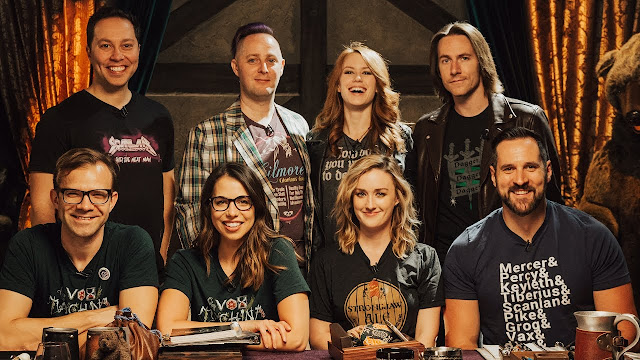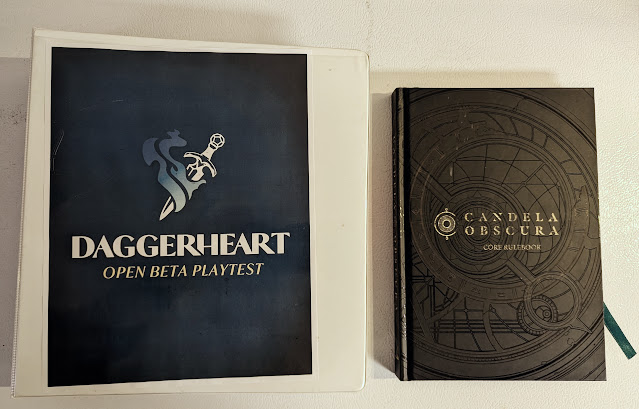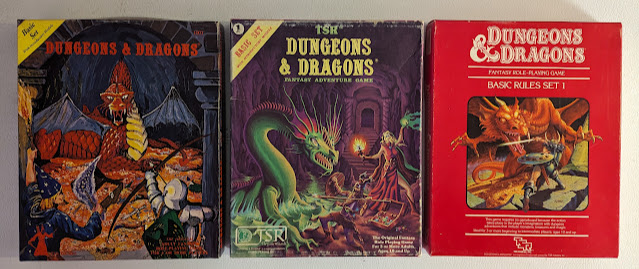One of the biggest cultural phenomenons to come out of modern D&D has been the success of Critical Role. It was successful because of D&D 5th Edition and, in turn, made D&D 5th Edition more successful.
What is Critical Role?
 |
| The voice actor players. |
It is a streamed "actual play" Dungeons & Dragons 5e (for the most part, more on that) game. Each session is about 4+ hours long (resulting in over 2,000 hours of content) and features a group of voice actors: (top L-R, picture above) Sam Riegel, Taliesin Jaffe, Marisha Ray, Dungeon Master Matt Mercer, and (bottom, L-R) Liam O'Brien, Laura Bailey, Ashley Johnson, and Travis Willingham.
They began just as a group of friends (Travis and Laura were either already married or dating, Matt and Marisha were dating) playing a D&D 4th Edition and then a Pathfinder game. When D&D 5e came out, they moved over to that. You can even see some rule confusion in the early episodes.
 |
| The characters. Can you match who is who? |
They soon became wildly popular. How popular? Well there is an Amazon series based on their first campaign ("Vox Machina"), there are several books about and by the Critical Role team, their Gen Con shows are sold out months in advance, and they also sold out Wembley Arena back in October of 2023. A live event to watch a bunch of friends play D&D, and they sold out a space that had previously seen sold-out shows of the likes of Led Zeppelin, Genesis, David Bowie, Queen, The Who, The Grateful Dead, and more.
While they were not the first online Actual Play D&D streamers, they are the biggest, and they made this into not just their own genre of entertainment, but they have been making an absolute ton of money.
There are three campaigns featuring different groups of characters. Campaign 1 featured the above characters in Vox Machina. Campaign 2 was their big breakthrough campaign featuring the Mighty Nein. This also introduced Laura Bailey's character, Jester Lavorre, the tiefling that inspired a thousand cosplays.
There have also been four published books for the D&D 5e game.
The cultural phenomena that is Critical Role has not been without some critics. There are those that complain that they are not really gamers. Or that they are not really playing. Or that the "Mercer Effect" has ruined what people expect from D&D.
To those critics, I say, "Do you remember exactly when it was when you let fun die in your life?"
Look. The hobby space that D&D occupies now is not the same as it was in the 1980s. This is a good thing.
People can watch Critical Role and enjoy it without rolling any dice of their own. They can watch the show and then think, "Hey, this looks fun. I want to try this." They can cosplay Jester, Keyleth, or FCG. They can enjoy the Amazon Prime series.
For me, it is all great fun. I started watching the old streams (still on Campaign 1!), and I enjoy them. They have also given me ideas for my own games. Between Campaign 1 and "Stranger Things," there is a whole new generation of D&D fans out there. Yeah, so sometimes I get 20-year-olds excited to tell me all about Vecna (the BBG in both), but hey, they are excited.
The Future
Critical Role has been a huge money maker...for Critical Role. It should not surprise anyone that the Powers That Be at Hasbro (the current owners of Wizards of the Coast and D&D) wanted in on some of that action. So last year in January, Hasbro/WotC wanted to put out some new guidelines on what various creators can do with D&D material, essentially walking back on 23+ years of access and goodwill. Well, people naturally were angry. It was enough that I even stopped using the very permissible Open Gaming License to produce my own works and spent most of 2023 working on solutions. Others did the same. One of those solutions for the Critical Role team was to build their own RPG that they controlled and had all the rights to. It is a very good idea.
They began with an actual play series and a new game called Candella Obscura. It is a quasi-Victorian, horror-themed fantasy game, so you know I am interested! I have not played it yet, but we have the hardcover and it looks fun. You can try it out for free with their QuickStart Guide.
Their newest game is called Daggerheart. It is still being playtested, and I discussed it a while back. Will people leave D&D 5 for it? Well, there is some indication that D&D 5 sales dipped in 2023. Was that because of Wizards of the Coast's series of PR blunders or because D&D 5R (One D&D) is due out at the end of this year, and sales ALWAYS dip after these announcements? Hard to say, but it's likely a combination of both. But in any case I wish Daggerheart and the Critical Role team nothing but the best and hope they are wildly successful.
Even if you don't like Critical Role. The Stream, the Amazon show, their D&D 5e content, or new games, you have to like the attention they have brought to this hobby. Even if only 1/10th of the people drawn into this stick around for other games, that is more than we had before.
Tomorrow, I'll talk about a topic that is very near and dear to the hearts of many gamers. Dice!
This is also my first entry of the month for the RPG Blog Carnival, hosted by Codex Anathema on Favorite Settings.










.jpg)












